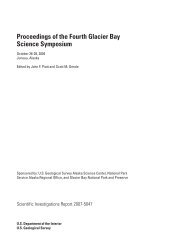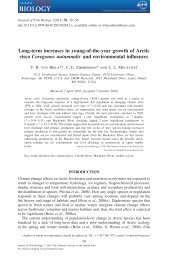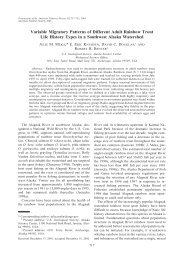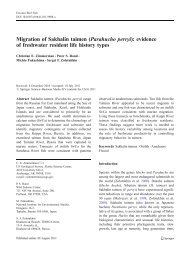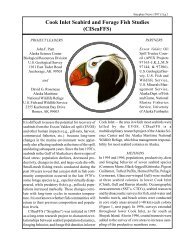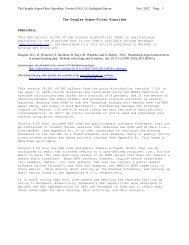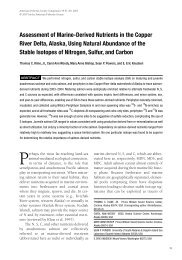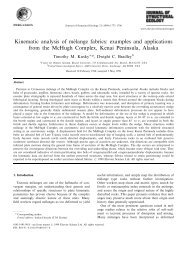Mexican native trouts: a review of their history and ... - Webspace
Mexican native trouts: a review of their history and ... - Webspace
Mexican native trouts: a review of their history and ... - Webspace
You also want an ePaper? Increase the reach of your titles
YUMPU automatically turns print PDFs into web optimized ePapers that Google loves.
292<br />
mentioned here are 3–4 years prior to those on<br />
his specimens at USNM – Table 1], from San<br />
Francisco, came from some scientific institution<br />
to study these trout. My boss, Mr. C.H. Cooper,<br />
the company manager, told me to accompany Mr.<br />
Miller to the different places where trout were<br />
more plentiful. We camped out several days <strong>and</strong><br />
Miller, who must have been about 70 years old,<br />
collected hundreds <strong>of</strong> specimens, from tiny half<br />
inch fry up to 8–9 inches. I think we had about 8 or<br />
10 gallon jugs filled with formaldehyde in which<br />
he put all he caught. He used seines, <strong>and</strong> he stirred<br />
up the fish by h<strong>and</strong> in the cavities alongside the<br />
streams, <strong>and</strong> when he had had enough we came<br />
back to the lumber camp. These jugs were well<br />
packed in lumber crates for protection <strong>and</strong> taken<br />
back to the States by Miller. I was called to the<br />
Army in 1943 <strong>and</strong> do not know what the outcome<br />
<strong>of</strong> this trip was.<br />
On several occasions when fishing on a stream<br />
south <strong>of</strong> El Salto called La Rosilla creek, I caught<br />
several trout which were entirely different. Larger<br />
(11-13-inches long), <strong>and</strong> the meat was <strong>of</strong> different<br />
color, rather salmon colored; the meat on the<br />
others was cream colored. I am listing the names <strong>of</strong><br />
the main streams where we used to fish: La Rosilla,<br />
Arroyo del Agua, Las Adjuntas, San Juan, Bajio<br />
Seco, Arroyo Hondo (I fished this last one about<br />
a couple <strong>of</strong> years ago <strong>and</strong> only caught three over<br />
a period <strong>of</strong> five hours, the longest one was about<br />
8-inches long), Paso de las Mulas, San Esteban,<br />
etc. People say that the streams are pretty well<br />
fished out, <strong>and</strong> there are other factors which do not<br />
make camping out as safe as it used to be. It makes<br />
me feel pretty good that Dad sent those five specimens<br />
that you mentioned. I am surprised to hear<br />
that trout have been planted up in those streams,<br />
I’ve never heard about it from any other source.<br />
I worked for the lumber company from 1937 to<br />
1950, <strong>and</strong> have been going back very <strong>of</strong>ten, but I<br />
never heard <strong>of</strong> the practice.<br />
We interpret the information from the Bishop<br />
family as supporting the hypothesis that trout are<br />
<strong>native</strong> to the Río Presidio <strong>and</strong> other nearby drainages.<br />
Despite Stilwell’s (Stilwell, 1948) suggestion to the<br />
contrary, it seems highly unlikely that rainbow trout<br />
could have been stocked <strong>and</strong> established over such an<br />
extensive <strong>and</strong> remote area as Mr. Bishop describes<br />
so quickly after the initial 1888 arrival <strong>of</strong> rainbow<br />
trout eggs to the Mexico City area for cultivation. The<br />
government’s trout culture guide published in 1892<br />
(Secretaría de Fomento, 1892) stated (in its title) that<br />
rainbow trout would first be available for distribution<br />
(from the Chimaleápam station near Mexico City) in<br />
1893, thus leaving only about 10 years for distant<br />
<strong>and</strong> very remote parts <strong>of</strong> mountainous Durango to<br />
be widely stocked <strong>and</strong> large populations to become<br />
established for the far-flung fishing adventures <strong>of</strong> the<br />
Bishop family (<strong>and</strong> others) by shortly after the turn<br />
<strong>of</strong> the century. Additionally, if rainbow trout stocking<br />
was so prevalent early-on, <strong>and</strong> particularly, as Stilwell<br />
(Stilwell, 1948), Miller (1960) <strong>and</strong> Miller <strong>and</strong> Smith<br />
(1986) argued, promoted by American workers in the<br />
area, it seems unlikely that the Bishops, who obviously<br />
spent much time fishing <strong>and</strong> were obviously leaders <strong>of</strong><br />
the American ex-patriot <strong>and</strong> local communities, would<br />
not have known <strong>of</strong> the practice. Furthermore, simply<br />
getting hatchery rainbow stock into the area at all was<br />
not nearly as easy as Miller surmised. For example, the<br />
railroad did not arrive to El Salto until the 1920s, prior<br />
to which it was accessible only by a two or three-day<br />
ride on mules from the capital city <strong>of</strong> Durango.<br />
Seth Eugene Meek. Needham <strong>and</strong> Gard (1959)<br />
correctly summarized Meek’s (1904) mention <strong>of</strong><br />
trout west <strong>of</strong> Ciudad Durango as well as E. W.<br />
Nelson’s visit to El Salto <strong>and</strong> his obtaining a series <strong>of</strong><br />
specimens from there in the fall <strong>of</strong> 1907 (Evermann,<br />
1908). Unfortunately, as seems to be the case with<br />
other early collections <strong>of</strong> <strong>Mexican</strong> <strong>trouts</strong>, the 1907<br />
specimens (<strong>and</strong> apparently any that Nelson may<br />
have collected to the same area on his visit in 1898<br />
(Evermann, 1908)) disappeared <strong>and</strong> were never<br />
described.<br />
Aldo Leopold. Two visits to the Sierra Madre Occidental<br />
between 1936 <strong>and</strong> 1938 had a pr<strong>of</strong>ound effect<br />
on Aldo Leopold, one <strong>of</strong> the most influential thinkers<br />
in conservation <strong>history</strong> (Forbes <strong>and</strong> Haas, 2000).<br />
Leopold’s unusually perceptive field skills led him<br />
to question the impact <strong>of</strong> modern man on the pineoak<br />
ecosystem <strong>of</strong> the southwestern United States, <strong>and</strong><br />
sound a surprisingly early warning against genetic<br />
contamination <strong>of</strong> <strong>native</strong> <strong>trouts</strong> by introduced stocks<br />
(Leopold, 1918). He also warned against overgrazing<br />
that was already leading to brush encroachment,<br />
erosion, <strong>and</strong> altered fire <strong>and</strong> hydrological<br />
regimes in the southwestern U.S. (Leopold, 1924).<br />
Upon becoming the nation’s first pr<strong>of</strong>essor <strong>of</strong> wildlife<br />
management in the 1930s, Leopold tried to resolve<br />
widespread deer population explosions, <strong>and</strong> visited




